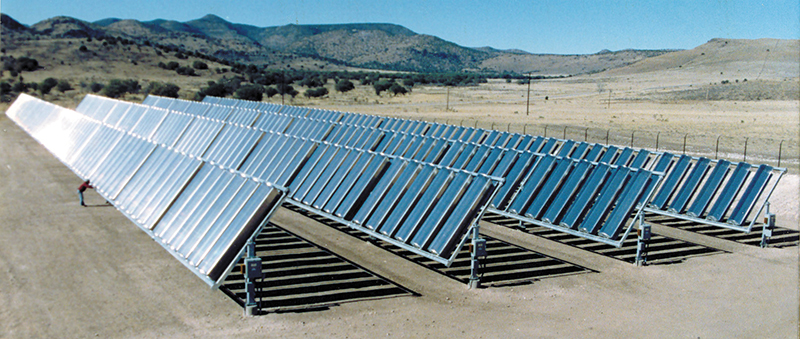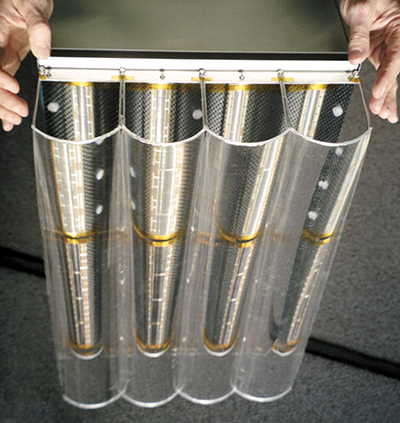
Shedding Light on Solar Power
In the late 1970s, ENTECH, Inc., of Keller, Texas, developed a solar power concentrator for terrestrial applications that was spun into a concentrator for space in the early 1980s. Nearly 25 years later, the company has gone back to its terrestrial roots with a new concentrator that is a direct spinoff from its space technology.
In journeying back and forth between Earth and space, ENTECH formed strong business relationships with various U.S. Government agencies, including NASA, which expressed interest in the company's expertise and understanding of solar concentrators and solar energy conversion. Specifically, the company was building solar power concentrators using Fresnel lenses that efficiently convert the sun's energy into electricity by concentrating sunlight onto photovoltaic cells, or solar cells, which are non-mechanical devices made from silicon alloys. Sunlight is composed of particles of solar energy called photons, and when these particles strike a photovoltaic cell, they may be reflected, pass right through, or be absorbed. Only a portion of the absorbed photons provides energy to generate electricity.
ENTECH's Fresnel lens concentrators possess a shape error tolerance more than 200 times higher than other reflective concentrator approaches, making mass production, installation, and long-term operation in an outdoor environment far more practical than for other comparable systems. Additionally, by using air-cooled photovoltaic cells to convert concentrated sunlight to electricity, ENTECH is able to avoid all of the complexities associated with the fluids and conversion machinery used for solar thermal conversion.
For the past 2 decades, ENTECH has worked exclusively with Fresnel lens concentrators. As a result, the company developed two commercial solar array product lines: the SunLine Array for small power terrestrial applications, and the SolarRow Array for large power terrestrial applications. The SunLine product utilizes two concentrator modules, providing an output of roughly 800 watts under peak sunlight conditions, and is intended for remote and residential applications. On a much grander scale, the SolarRow product uses 72 concentrator modules in the world's largest two-axis sun-tracking structure, which is longer than a football field, according to ENTECH. SolarRows have an output of about 25 kilowatts each under peak sunlight conditions, and are designed to produce electricity at power plant capacity levels.
In the late 1980s, NASA's Glenn Research Center sponsored a Small Business Innovation Research (SBIR) contract with ENTECH, in which the company worked to mold its successful terrestrial concentrator technology into applications that would generate power for space missions. ENTECH's first application made use of small, dome-shaped Fresnel lenses to direct sunlight onto high-efficiency photovoltaic cells. After some key adjustments, the mini-dome lens array was flown as part of the U.S. Air Force/NASA Photovoltaic Array Space Power Plus Diagnostics (PASP Plus) flight experiment in 1994. This flight also included 11 other leading photovoltaic array technologies. According to ENTECH, its mini-dome lens array achieved the best performance and the least degradation of all 12 arrays in the year-long mission, which flew through the Van Allen Belts in a high-radiation elliptical orbit.
Due to their three-dimensional shape, the mini-dome lenses entailed construction by a batch molding process, which is naturally more costly than a continuous process. To overcome this disadvantage and meet the requirement for precise solar pointing in two axes, ENTECH started developing solar concentrator arrays for space using a line-focus lens that can be mass-produced by a continuous process.
This new technology, referred to as Solar Concentrator Array with Refractive Linear Element Technology (SCARLET), was created with support from Glenn and the Ballistic Missile Defense Organization, now officially known as the Missile Defense Agency (MDA). It was used to power the NASA/Jet Propulsion Laboratory Deep Space 1 spacecraft, which successfully completed two extraterrestrial rendezvous, first with asteroid Braille in July 1999, and later with comet Borrelly in September 2001. In addition to supplying power for the spacecraft, SCARLET was used to power the ion engine that enabled the probe to reach its two close encounter targets. The SCARLET array has won numerous honors, including the Schreiber-Spence Technology Achievement Award in 1999, and the prestigious NASA Turning Goals into Reality Award in 2001.
The ENTECH research team is currently testing a new ultra-light offspring of SCARLET, called the Stretched Lens Array (SLA), to be used for future space missions. Compared to the original unit, the SLA offers 50-percent higher power density and 300-percent better specific power, according to the company. In 2000, under a Space Solar Power contract with NASA's Marshall Space Flight Center, ENTECH created the first prototype panel of the new SLA technology, and submitted it for further testing at Glenn. The company is currently enhancing the SLA concept under an Advanced Cross-Enterprise Technology Development contract with Glenn, and is planning to deliver a four-panel demonstration unit within the next year.
With space-qualified hardware development efforts underway, research continues to improve the performance of the SLA concept. ENTECH set a world record by measuring over 27-percent net operational efficiency for a small SLA module in outdoor testing. To verify the accuracy of this world-record-level efficiency, the company sent the module to the Golden, Colorado-based National Renewable Energy Laboratory (NREL) for independent testing. NREL confirmed that the SLA technology set the record, despite the fact that the array was optimized for space, not Earth.
Upon further testing with advanced solar cell technology in 2001, ENTECH surpassed its previous record by measuring a 30-percent net operational efficiency for the SLA. The company, with support from the U.S. Department of Energy, believes that the SLA is the first solar device of any kind to break the 30-percent solar-to-electric conversion efficiency barrier in outdoor testing. The former world record for any type of solar device tested in an outside environment was a 29.4-percent efficiency rate, set in 1984 by a parabolic dish/Stirling engine unit. ENTECH is now actively developing its next-generation terrestrial concentrator products to incorporate the new lens and cell technology initially developed for space applications.
Building on this recent accomplishment, ENTECH hopes that its super-efficient concentrator technology will light the way for consumers and provide a significant contribution to the Nation's electricity supply for decades to come.

The Stretched Lens Array set a world record for net operational efficiency in outdoor testing.

ENTECH, Inc.’s SolarRow Arrays are designed to produce electricity at power plant capacity levels.













